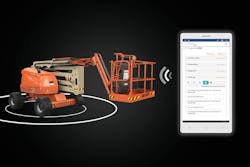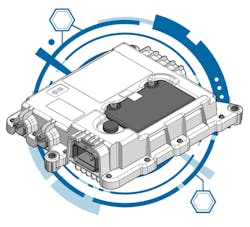Telematics Aids Boom Lift Effectiveness
With the majority of boom lift sales still going to rental companies, it’s easy to forget there are also contractor buyers—but both groups can now take advantage of valuable telematics technology that has migrated from the earthmoving realm to the lift industry.
The migration has taken time, as has fleet buy-in, but there are many reasons for managers to climb on board.
“Although telematics in construction equipment has been around for more than 20 years, there are still plenty of fleet managers who have yet to begin taking advantage of this technology,” says Misty Mason, product manager, digital solutions, for JLG. “In fact, estimates show that only 20 to 30 percent of equipment fleet companies are currently leveraging telematics on their fleet.
“Why is it taking so long for the remaining construction sectors, including the aerial equipment market, to adopt telematics? There are many reasons why companies have been late-adopters of telematics,” Mason says. “Some had up-front investment concerns, spurred by a general lack of understanding, others expressed the fear of managing the data and the anxiety over related IT concerns. All of which have eased over time as systems have become more commonplace.”
Rental use of telematics in the category has decidedly increased as more boom manufacturers have developed offerings. Two of the more recent examples are Elevate from Skyjack (in cooperation with Trackunit) and Haulotte’s just-released Sherpal.
“As the construction industry continues to modernize its business operation, telematics technology is now being widely adopted and more commonly used in the aerial rental market,” says Christine Zeznick, Genie’s director of product and business development.
“With the industry learning more and more about how to utilize this technology in their business operations, today’s telematics can offer significant competitive advantages to rental companies, including cost savings on parts and labor and reduced costs on maintenance and service charges, all of which result in increased rental return on invested capital [ROIC],” Zeznick says.
“Thinking about telematics from a high-level perspective, it’s easy to highlight the benefits of implementing this technology,” Zeznick continues. “But it seems that many rental professionals are still confused as to how it can benefit their businesses on a day-to-day basis. This is completely understandable—access to too much data without knowing how to harness it can be extremely overwhelming.”
Genie’s telematics technology is called Lift Connect, which was launched in 2015 as Telematics Ready Connector. At that time, it allowed access for mixed fleets to a few key data points and was a plug-and-play solution.
The company says its customers appreciated the flexible approach but wanted more data and information. They also told Genie the system was hard to leverage because of mixed fleets and multiple telematics platforms.
With the development of standard APIs and managers’ increasing desire for dashboards and alerts, the company introduced Lift Connect in 2019, working with telematics partner ZTR.
Lift Connect lets managers collect data in two ways, via the Lift Connect portal or through their existing system, consuming the data via a standard API.
Above: Haulotte’s Sherpal telematics device.
Genie says it shares more info than any other manufacturer in its industry, including hours, fault codes, future failure prediction, and machine health—maintenance prescriptions based on how the machine is actually being used. The benefits are broken down for fleet managers and service managers, and not necessarily for renters versus buyers.
Fleet managers can utilize the program to understand the health of the fleet in a single view; leverage fleet reporting and dashboards to identify exceptions and reduce downtime; search directly for individual asset numbers or models; and understand machine utilization and drive ROIC.
Service managers can remotely diagnose equipment, saving time and costly service visits; view machines with upcoming maintenance for planning purposes; and view alert dashboards to identify if action should be taken.
But renters do realize specific telematics benefits, according to Zeznick.
“Data, on its own, may feel like one more thing a rental company needs to process and make actionable,” she says. “And to a lot of people in the rental industry, telematics used to feel like that—more work. However, today’s telematics programs have evolved from just data to actionable information, allowing rental companies to manage fleets more efficiently, saving time and reducing operating costs.”
JLG’s ClearSky telematics system was also developed to help customers better manage their time and assets. Its goal is to limit time on routine maintenance; limit time lost due to low batteries; give users utilization data as to when, where, and how their lifts are being used; and to provide CANBUS-gathered data to drive proactive service management. In addition, geofences and time fences based on GPS data will protect the machines from theft and unauthorized use.
Going a step further, JLG also has a related augmented reality (AR) app that offers managers additional planning help.
The app uses five tools to help managers plan projects, manage equipment, and facilitate machine selection. They are: Machine Visualization, which makes sure users have the right equipment for any job by placing and moving virtual machines in the actual job site; Kit Visualization, the ability to stock or buy the right accessories for any job by viewing them on the actual real equipment or in the space where they will be used; Operation Guidance, which promotes safe machine operation with control panel guidance in the user’s choice of languages; Decal Viewer, a feature that shows decal information in a choice of languages and explains symbols and images; and Inspection Assistance, involving inspection details and information shown on the machine being inspected.
“The JLG AR app allows contractors to virtually place and maneuver a machine in the space in which it will be used,” says Jennifer Stiansen, director of marketing, JLG. Both ClearSky and the AR app are available for desktop and mobile users.
“Once a rental company decides to invest in a telematics solution to enhance their fleet management processes, establishing some essential best management practices will help them to make the most of the investment,” Mason says.
“It starts with understanding specific fleet management needs and concerns by taking note of specific, real-life occurrences or situations that presented a fleet management challenge or issue in the past,” Mason says. “This knowledge can point out specific business needs that a telematics solution can help address.”
Mason stresses that fleet management isn’t a one-size-fits-all activity. “Fleet management best practices take into account an equipment fleet’s operational efficiency, operational cost effectiveness, operator management, equipment maintenance, and equipment safety and compliance.
“Monitoring and tracking these five factors on each machine in an aerial equipment rental fleet may seem like a daunting task at first, but through the use of today’s modern telematics solutions, it’s easy to gather, read, and understand the information machines are providing,” Mason says.
JLG says it has seen a difference in telematics features most often used by renters versus buyers. Rental houses and renters tend to use location to help with service planning and cuts on downtime for field techs; fault codes to get machines back on rent quicker; machine hours to help with billing and knowing when to service machines; battery status; machine utilization; setting geofences/timefences to protect investment and to be notified on machine usage (leaving a particular area or being used before/after a designated time); and scheduling maintenance.
Through the JLG ClearSky portal, Mason says, users tend to spend more time viewing the equipment maintenance pages, the map/machine location, geofences, and fault code reports.
“The features that JLG sees being used most by buyers are using telematics to plan for customer visits and rental services, the ability to locate machines quickly on a job site, fault codes that can save time and money, and scheduling maintenance to help protect the investment,” Mason says.
“Keep in mind, not every telematics platform is the same,” Genie’s Zeznick says. “So it’s important for rental companies to choose one that provides the best user experience and presents telematics data as actionable information.”
There are other benefits, as well. It allows managers access to specific information on machine inventory, such as location, whether it is operating or sitting idle, what position the key switch is in, and whether the parking brake is engaged. In addition, other data includes machine hours, how often and long the machine is used in a day, per week, and per month, as well as the presence of faults. Preventive maintenance-wise, there is information on the last scheduled maintenance, engine hours, how many hours the engine has run on a particular rental, and remote diagnostics—avoiding, or being prepared for, service calls before they happen.
“Using telematics as the hub for fleet management can do a lot for rental companies and their customers,” Zeznick says. “If a machine goes missing, telematics can be used to quickly determine where it is. And, ensuring that all preventative maintenance is performed according to schedule is no longer a tedious process. When a customer has an issue with a machine, rental staff can read any fault codes, real-time from their computer, while on the phone with the customer,” Zeznick says. “Telematics also means more proactive customer support, which helps them maximize on-the-job uptime. Quick responsive customer support is likely a big reason why customers choose their rental partners in the first place.
“For our rental customers, they may be less interested in the machine’s components and more interested in the machine’s general health and operating condition, including battery life, fuel levels, operating hours, and current location, as well as if their rental units are achieving maximum utilization,” Zeznick says. “Telematics enables rental companies to dive deeper into machine reporting data to get a more complete picture of the fleet’s health, its operating status in the field, and when maintenance is required.”

